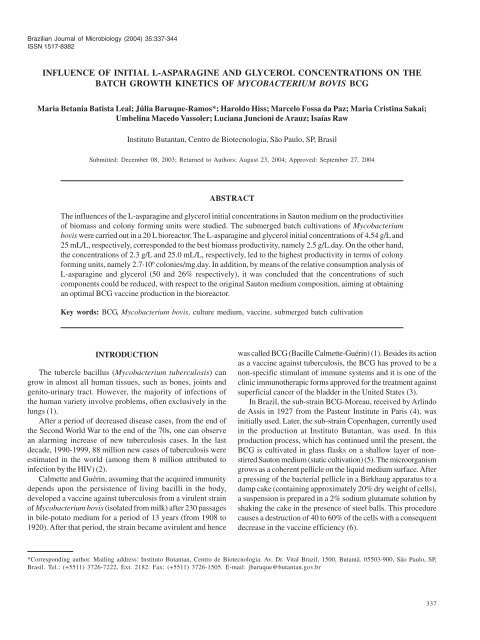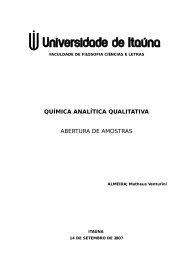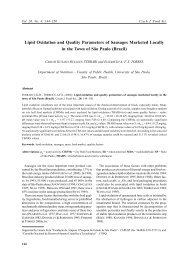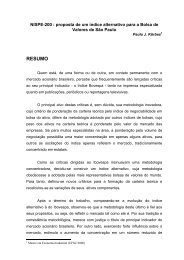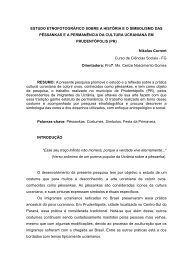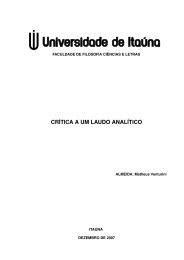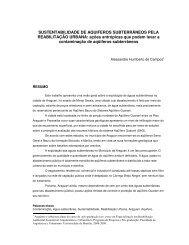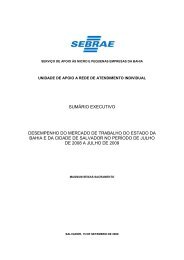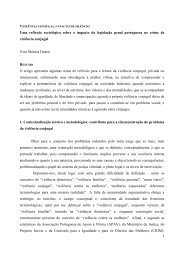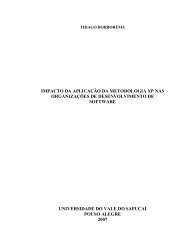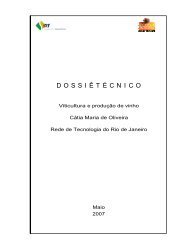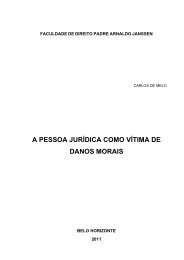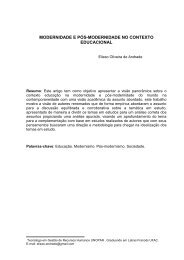MAL 007
MAL 007
MAL 007
Create successful ePaper yourself
Turn your PDF publications into a flip-book with our unique Google optimized e-Paper software.
Brazilian Journal of Microbiology (2004) 35:337-344<br />
ISSN 1517-8382<br />
INFLUENCE OF INITIAL L-ASPARAGINE AND GLYCEROL CONCENTRATIONS ON THE<br />
BATCH GROWTH KINETICS OF MYCOBACTERIUM BOVIS BCG<br />
Maria Betania Batista Leal; Júlia Baruque-Ramos*; Haroldo Hiss; Marcelo Fossa da Paz; Maria Cristina Sakai;<br />
Umbelina Macedo Vassoler; Luciana Juncioni de Arauz; Isaías Raw<br />
Instituto Butantan, Centro de Biotecnologia, São Paulo, SP, Brasil<br />
Submitted: December 08, 2003; Returned to Authors: August 23, 2004; Approved: September 27, 2004<br />
ABSTRACT<br />
The influences of the L-asparagine and glycerol initial concentrations in Sauton medium on the productivities<br />
of biomass and colony forming units were studied. The submerged batch cultivations of Mycobacterium<br />
bovis were carried out in a 20 L bioreactor. The L-asparagine and glycerol initial concentrations of 4.54 g/L and<br />
25 mL/L, respectively, corresponded to the best biomass productivity, namely 2.5 g/L.day. On the other hand,<br />
the concentrations of 2.3 g/L and 25.0 mL/L, respectively, led to the highest productivity in terms of colony<br />
forming units, namely 2.7·10 6 colonies/mg.day. In addition, by means of the relative consumption analysis of<br />
L-asparagine and glycerol (50 and 26% respectively), it was concluded that the concentrations of such<br />
components could be reduced, with respect to the original Sauton medium composition, aiming at obtaining<br />
an optimal BCG vaccine production in the bioreactor.<br />
Key words: BCG, Mycobacterium bovis, culture medium, vaccine, submerged batch cultivation<br />
INTRODUCTION<br />
The tubercle bacillus (Mycobacterium tuberculosis) can<br />
grow in almost all human tissues, such as bones, joints and<br />
genito-urinary tract. However, the majority of infections of<br />
the human variety involve problems, often exclusively in the<br />
lungs (1).<br />
After a period of decreased disease cases, from the end of<br />
the Second World War to the end of the 70s, one can observe<br />
an alarming increase of new tuberculosis cases. In the last<br />
decade, 1990-1999, 88 million new cases of tuberculosis were<br />
estimated in the world (among them 8 million attributed to<br />
infection by the HIV) (2).<br />
Calmette and Guérin, assuming that the acquired immunity<br />
depends upon the persistence of living bacilli in the body,<br />
developed a vaccine against tuberculosis from a virulent strain<br />
of Mycobacterium bovis (isolated from milk) after 230 passages<br />
in bile-potato medium for a period of 13 years (from 1908 to<br />
1920). After that period, the strain became avirulent and hence<br />
was called BCG (Bacille Calmette-Guérin) (1). Besides its action<br />
as a vaccine against tuberculosis, the BCG has proved to be a<br />
non-specific stimulant of immune systems and it is one of the<br />
clinic immunotherapic forms approved for the treatment against<br />
superficial cancer of the bladder in the United States (3).<br />
In Brazil, the sub-strain BCG-Moreau, received by Arlindo<br />
de Assis in 1927 from the Pasteur Institute in Paris (4), was<br />
initially used. Later, the sub-strain Copenhagen, currently used<br />
in the production at Instituto Butantan, was used. In this<br />
production process, which has continued until the present, the<br />
BCG is cultivated in glass flasks on a shallow layer of nonstirred<br />
Sauton medium (static cultivation) (5). The microorganism<br />
grows as a coherent pellicle on the liquid medium surface. After<br />
a pressing of the bacterial pellicle in a Birkhaug apparatus to a<br />
damp cake (containing approximately 20% dry weight of cells),<br />
a suspension is prepared in a 2% sodium glutamate solution by<br />
shaking the cake in the presence of steel balls. This procedure<br />
causes a destruction of 40 to 60% of the cells with a consequent<br />
decrease in the vaccine efficiency (6).<br />
*Corresponding author. Mailing address: Instituto Butantan, Centro de Biotecnologia. Av. Dr. Vital Brazil, 1500, Butantã. 05503-900, São Paulo, SP,<br />
Brasil. Tel.: (+5511) 3726-7222, Ext. 2182. Fax: (+5511) 3726-1505. E-mail: jbaruque@butantan.gov.br<br />
337
M.B.B. Leal et al.<br />
The purpose of this work is to study the production of the<br />
BCG vaccine in dispersed cultivation in the bioreactor<br />
(avoiding thus the further bacillary dispersion with steel balls).<br />
From this, a desirable increase of the viable cells follows, in<br />
comparison to the static cultivation. As described by Gheorghiu<br />
(7), the submerged cultivation also produces bacteria which<br />
are more resistant to the freeze-drying process and storage at<br />
room temperature than the bacteria produced by static<br />
cultivation. More specifically, the purpose of this work is to<br />
study the influence of the initial L-asparagine and glycerol<br />
concentrations in Sauton medium on growth, in order to adapt<br />
the composition of this medium for the submerged batch<br />
cultivation.<br />
338<br />
MATERIALS AND METHODS<br />
Microorganism<br />
For the preliminary runs in shaker flasks, ampoules of BCG<br />
were employed as inoculum (Moreau strain from Copenhagen -<br />
secondary seed lot), each containing 5 mg of the lyophilized<br />
microorganism dated July 1978.<br />
For the runs in bioreactor, ampoules from the Production<br />
Laboratory of the Butantan Institute were used (lyophilized -<br />
lot 3/95 BCG ID).<br />
Culture medium<br />
The Sauton medium was used (5) for the inoculum and<br />
bioreactor cultivations with the following composition: Lasparagine,<br />
4.54 g/L; citric acid, 2.0 g/L; K2HPO4, 0.5 g/L;<br />
MgSO4.7H2O, 1.0 g/L; ferriammonium citrate, 0.05 g/L; glycerol,<br />
60.0 mL/L (v/v). The pH was adjusted to 7.2 with a 4 N NaOH<br />
solution.<br />
The cultivation media were sterilized by filtration through a<br />
0.2 µm membrane for preliminary experiments 1 to 4. For the<br />
assays carried out in the bioreactor (5 to 13) the cultivation<br />
media were sterilized inside the vessel at 121ºC for 30 min. Besides<br />
the fact that the sterilization by wet heat is easier than filtration,<br />
it was verified that heating the medium did not cause alterations<br />
in the growth kinetics (8).<br />
The modifications of the initial L-asparagine and glycerol<br />
concentrations with respect to the original Sauton medium<br />
composition are expressed in Table 1.<br />
Table 1. Factorial planning design and result analysis for preliminary experiments 1 to 4 carried out in shaker.<br />
(X1) Tween-80 (v/v): 0 (-)/0.025 % (+)<br />
(X2) Glycerol (mL/L): 25 (-)/60 (+) 1<br />
(X3) L-asparagine.H2O (g/L): 2.27 (-)/4.54 (+) 1<br />
Erlenmeyer Average Factorial Planning of Assays Interaction Effects Dry<br />
Number Calculation (X1) (X2) (X3) X1X2 X1X3 X2X3 X1X2X3 Biomass2<br />
1 + + + + + + + + 0<br />
2 + + + - + - - - 0<br />
3 + + - + - + - - 0<br />
4 + + - - - - + + 0<br />
5 + - + + - - + - 4.59<br />
6 + - + - - + - + 3.38<br />
7 + - - + + - - + 3.16<br />
8 + - - - + + + - 2.76<br />
Divisor 8 4 4 4 4 4 4 4 ——<br />
Average= 1.74± 0.25<br />
Effect of (X1)= -3.48±0.51<br />
Effect of (X2)= 0.51±0,51<br />
Effect of (X3)= 0.40±0.51<br />
Interaction Effect (X1X2)= -0.51±0.51<br />
Interaction Effect (X1X3)= 0.40±0.51<br />
Interaction Effect (X2X3)= -0.20±0.51<br />
Interaction Effect (X1X2X3)= -0.20±0.51<br />
1 Original concentrations in Sauton medium: 60 mL/L and 4.54 g/L of glycerol and L-asparagine respectively;<br />
2 Average of experiments 1 to 4. Expressed in total dry biomass per erlenmeyer contents (g).
Preparation of inoculum<br />
In a 300 mL erlenmeyer flask, 100 mL of Sauton medium were<br />
inoculated with the contents of one ampoule. The flask was<br />
agitated on a rotatory shaker at 198 min -1 , 37ºC, for 13 days.<br />
This culture was used as inoculum for the preliminary runs in<br />
shaken flasks and the same procedure was adopted for the<br />
inoculation of the bioreactor.<br />
Cultivation conditions<br />
Preliminary cultivation runs<br />
Eight cultivation runs were carried out according to the<br />
factorial planning design 2 3 (9) (see Table 1), repeated four times<br />
(assays 1 to 4), each one in shaken flasks of 300 mL of capacity<br />
with 100 mL of Sauton medium, agitated at 198 min -1 and<br />
temperature controlled at 37 ± 0.5ºC. The values adopted for the<br />
initial concentrations of L-asparagine, glycerol and Tween 80 in<br />
the Sauton medium are also listed in Table 1. The Tween 80 was<br />
used as a dispersing agent.<br />
The analysis of the influence indicated in Table 1 was based<br />
on the dry biomasses formed in each flask contents after 13<br />
days of cultivation.<br />
Cultivation runs in bioreactor<br />
The experiments were carried out in a 20 L bioreactor (LSL<br />
Biolafitte S.A., Saint Germain en Laye, France) constituted of a<br />
stirred cylindrical vessel of borosilicate glass with a half<br />
spherical bottom (50 cm diameter) and a top-driven agitator. A<br />
Growth kinetics of M. bovis<br />
marine propeller promoted the agitation with six blades set at a<br />
45º angle. This propeller was located 15 cm from the vessel<br />
bottom and the aeration was done at the surface medium into<br />
the vortex formed by the absence of baffles. The initial medium<br />
volume was near 12 L, the aeration rate corresponded to 15 L/<br />
min, the cultivation temperature was 37ºC and the manometric<br />
head vessel pressure was 4 cm Hg. The agitation frequency<br />
was 1200 min -1 for experiment 5 only and 840 min -1 for all other<br />
experiments. The initial pH of the Sauton medium was previously<br />
adjusted to 7.2 with a 4N NaOH solution.<br />
The initial adopted concentrations of L-asparagine and<br />
glycerol were equal to those of the preliminary experiments and<br />
a factorial planning design 2 2 was done as shown in Table 2.<br />
Analytical methods<br />
Cell Concentration. Expressed as dry biomass, determined<br />
by filtration of a sample in quantitative paper, followed by the<br />
pellet drying at 60ºC for 48 h. The obtained cell concentration<br />
value, multiplied by the medium volume, was transformed into<br />
total dry biomass (Mx) in order to exclude the medium<br />
evaporation effect on the mentioned concentration (10).<br />
Glycerol Concentration. The method used (11) was based<br />
on the glycerol oxidation by sodium periodate, in which glycerol<br />
reacts with sodium periodate in acid solution generating<br />
aldehyde and formic acid. The formic acid was titrated with a<br />
NaOH solution (0.125 N) and the volume spent corresponded<br />
Table 2. Factorial planning design and result analysis for experiments 5 to 6 carried out in bioreactor.<br />
(X2) Glycerol (mL/L): 25 (-)/60 (+)<br />
(X3) L-asparagine.H2O (g/L): 2.27 (-)/4.54 (+)<br />
Assay<br />
Agitation<br />
µmax PCFU.10-6 Number<br />
X2 X3 X2X3 Frequency<br />
(day<br />
PMx<br />
L-asparagine Glycerol<br />
-1 (min<br />
) (CFU/mg.day) (g/day)<br />
consumption consumption<br />
-1 ) (%) (%)<br />
5 + + + 1200 0.08 —— 0.16 20.3 19.6<br />
6 + + + 840 0.44 —— 2.25 30.5 23.0<br />
7 + + + 840 0.24 1.68 1.83 41.1 27.7<br />
8 - + - 840 0.38 1.21 2.472 38.6 33.3<br />
9 - + - 840 0.41 0.25 2.532 34.7 30.8<br />
10 + - - 840 0.33 1.42 2.41 42.1 25.0<br />
11 + - - 840 0.40 —— 2.16 32.5 16.2<br />
12 - - + 840 0.33 2.011 2.24 49.63 21.34 13 - - + 840 0.30 3.351 2.17 51.13 30.74 1 Maximum average for PCFU = 2.68.10 6 UFC/mg.day;<br />
2 Maximum average for PMx = 2.50 g/day;<br />
3 Maximum average for L-asparagine consumption = 50%;<br />
4 Maximum average for glycerol consumption = 26%.<br />
339
M.B.B. Leal et al.<br />
to the glycerol concentration. This result multiplied by the<br />
medium volume was transformed into total mass of glycerol<br />
(MG).<br />
Supernatant Total Nitrogen Concentration. Estimated using<br />
the Semi-Micro Kjeldahl method (12) through digestion with<br />
sulfuric acid and copper sulfate as catalyst for 4 hours. The<br />
ammonium sulfate formed was distilled in the presence of NaOH<br />
10N to discharge the ammonia vapor (13), which was absorbed<br />
in a boric acid solution in the presence of a mixed indicator<br />
followed by titration with a standard solution of HCl. The HCl<br />
expended corresponded to the nitrogen in the sample, according<br />
to the equation:<br />
340<br />
Nit.(g/L) = 1.401.107 . V . N<br />
Al<br />
(1)<br />
where,<br />
V = HCl expended volume (mL);<br />
N = HCl normality;<br />
A1 = sample volume (mL).<br />
This value, multiplied by the medium volume, was<br />
transformed in total supernatant nitrogen mass (MN).<br />
Colony Forming Units (CFU). Determined by a counting of<br />
the colonies grown in Loewenstein-Jensen agar-medium (4) at<br />
37ºC for 28 days, of a sample previously diluted (1:4) with<br />
sterilized Sauton medium. The calculation was based on the<br />
statistic method recommended by the OMS (14).<br />
Percentage of Dissolved Oxygen. Determined by an on-line<br />
polarographic probe (Ingold model Oxygraf 400) installed and<br />
sterilized together with the vessel. The saturation point (100%)<br />
was calibrated before the inoculation, under the same cultivation<br />
conditions (37ºC, 4 cm Hg head vessel pressure, agitation as<br />
the cultivation condition).<br />
Sterility Test. This control was done through the inoculation<br />
of 0.5 mL of the sample in a test tube containing Brewer medium<br />
(4), maintained at 37ºC (for bacteria presence detection), and in<br />
another tube with casein soya broth (15) maintained at room<br />
temperature (for fungi detection). The tubes were inoculated<br />
for a period of a week or more.<br />
Two staining methods: one, the Ziehl-Neelsen (4) for<br />
microscopic mycobacteria detection and the other, the Gram<br />
test (4) for eventual observations of contaminants, were also<br />
employed.<br />
Maximum specific growth rate (µmax). It was calculated<br />
according to the following equations for the exponential<br />
phase:<br />
log (Mx) = a ⋅ (t-ti) + b (2)<br />
ln (Mx) = 2.303 ⋅ a ⋅ (t-ti) + 2.303 ⋅ b (3)<br />
µmax = 2.303 ⋅ a ⋅ = (1/Mx) ⋅ (dMx/dt) (4)<br />
where,<br />
Mx (g) has the same meaning as defined in analytical<br />
methods at the cultivation time “t” (days);<br />
“a” is defined by equation 4;<br />
“b” represents the log of biomass Mxi at beginning of<br />
exponential phase ti.<br />
Dry biomass productivity (PMx). The time of the exponential<br />
growth phase end was taken to calculate the dry biomass<br />
productivity:<br />
PMx = (MXc – PXi)<br />
(Tc – ti)<br />
(5)<br />
where,<br />
MXc - total dry biomass at the exponential growth phase<br />
end (g);<br />
Tc - time of the exponential growth phase end (days).<br />
CFU productivity (PCFU). The minimum values observed of<br />
dissolved oxygen, during the process of cultivation coincided<br />
with the maximum values of CFU. In this way, this productivity<br />
was calculated in a similar way of equation (5):<br />
PCFU = (CFUm – CFUi)<br />
(tO min – ti)<br />
2<br />
(6)<br />
where,<br />
CFUm - maximum value of colony forming units,<br />
corresponding to the minimum dissolved oxygen in<br />
the medium, obtained after a semi-logarithmic fit<br />
between CFU and fermentation time (colonies/mg).<br />
CFUi - value of colony forming units at the beginning of<br />
the exponential growth phase (colonies/mg);<br />
tO2min - cultivation time corresponding to the minimum value<br />
of dissolved oxygen in cultivation medium (days).<br />
RESULTS<br />
Analysis of the effects in the factorial planning of the<br />
preliminary assays<br />
The calculated effects and their interactions are presented in<br />
Table 1. Considering that the highest negative effect is caused by<br />
X1, the conclusion is that the Tween-80 exerts an inhibitory effect<br />
on the cellular growth at an initial concentration of 0.025% (v/v).
Studies carried out by Sakai (8) show that such effect depends on<br />
the relation: Tween-80 concentration / cellular concentration.<br />
As for the L-asparagine and glycerol, the effects (X2 and<br />
X3) are positive for the highest concentrations of these<br />
components (Table 1: 4.54 and 60 mL/L respectively). Their<br />
differences, however, are not significantly high.<br />
These preliminary conclusions have, therefore, allowed for<br />
the planning of assays 5 to 13, carried out in submerged<br />
cultivations in the bioreactor. In these experiments no Tween-<br />
80 was added, but the levels of concentration for L-asparagine<br />
and glycerol were maintained.<br />
Analysis of results obtained in experiments carried out in<br />
bioreator<br />
The results are shown in Figs. 1 to 3 and Table 2.<br />
A similar cellular growth behavior was observed in all<br />
experiments, as it can be seen by comparing the growth curves.<br />
The exception was cultivation run 5 (Fig. 1) with a near absence<br />
of growth. In the same way, comparing the values of productivity<br />
(PMx) and maximum specific growth rate (µmax), shown in Table<br />
2, they are lower for run 5 than for the other assays. The agitator<br />
frequency of 1200 min -1 in run 5, higher than in the other<br />
experiments (840 min -1 ), explains such differences since<br />
vigorous mixing provokes mechanical stress, which is<br />
detrimental to growth (1).<br />
The CFU productivity was based on the minimum dissolved<br />
oxygen value (PCFU) because at this point it was the maximum<br />
viable count (8,16,17). Such behavior was also confirmed in this<br />
work, as it can be seen in figure 4: the maximum value of CFU<br />
Figure 1. Total dry biomass (Mx) obtained by the multiplication<br />
of the cell concentration value and the medium volume for<br />
experiments in bioreactors 5 to 13.<br />
Growth kinetics of M. bovis<br />
Figure 2. Total glycerol mass (MG) obtained by the multiplication<br />
of the glycerol concentration value and the medium volume for<br />
experiments in bioreactors 5 to 13.<br />
Figure 3. Total supernatant nitrogen mass (MN) obtained by<br />
the multiplication of the nitrogen concentration value and the<br />
medium volume for experiments in bioreactors 5 to 13.<br />
corresponds to the minimum value of oxygen concentration in<br />
the medium since the population of viables is responsible for<br />
the oxygen uptake. In addition, once a relationship between the<br />
number of living bacilli and the immunogenic potency was<br />
verified (18), the maximum value of colony forming units (CFUm)<br />
is important for the calculation of the related productivity, which,<br />
341
M.B.B. Leal et al.<br />
Figure 4. Dissolved oxygen in the medium (O2) and colony<br />
forming units (CFU) as a function of cultivation time.<br />
therefore, corresponds to the cultivation harvest time and<br />
consequently to a highly immunogenic BCG.<br />
The results in Table 2 show that the lowest initial glycerol<br />
and the highest L-asparagine concentrations implied the<br />
maximum dry biomass productivity (runs 8 and 9, PMx=2.50 g/<br />
day), but not the maximum CFU productivity (runs 12 and 13,<br />
PCFU=2.68⋅10 6 CFU/mg.day).<br />
Moreover, concerning relative consumption of substrates,<br />
shown in figures 1 to 3, it is possible to estimate the averages of<br />
global yield factors (YX/G=0.14 and YX/N=5.25 respectively),<br />
which led to an average relation (carbon/nitrogen) namely C/N<br />
≅16 (w/w). The maximum variation coefficient for these<br />
calculated averages was 30.0%.<br />
342<br />
DISCUSSION<br />
This microorganism generally grows as a surface veil in nonagitated<br />
culture flasks. In Instituto Butantan, the BCG lyophilized<br />
vaccine is supplied in vials with 10 doses, containing 1 mg of<br />
BCG lyophilized and between 2 to 10 million of live bacilli each.<br />
The production is 70,000 vials or 700,000 doses. For this purpose,<br />
96 L of Sauton medium are prepared weekly and distributed in<br />
aliquots of 80 mL (in flasks of 300 mL), totaling 1,200 flasks for the<br />
static cultivation of Mycobacterium bovis BCG (19). This<br />
represents an approximated concentration of 0.7 g of bacteria per<br />
liter of medium. In the present work higher values of dry biomass<br />
productivity and CFU productivity are obtained (Table 2). These<br />
data are truly promising regarding process transposition from<br />
static to submerged cultivation in bioreactors.<br />
The increase of the BCG production is a public necessity<br />
considering it is the most widely used vaccine in the world against<br />
tuberculosis. Besides this, it is a useful vaccine for delivering<br />
protective antigens of multiple pathogens (20). Since the early<br />
90s the BCG has been studied for this purpose because of its<br />
unique characteristics, including low toxicity adjuvant potential<br />
and long-lasting immunity (21). These recombinant BCG strains<br />
can elicit long-lasting humoral and cellular immune responses to<br />
foreign antigens (22). Several studies were done with this<br />
approach for developing vaccines against diverse diseases: AIDS<br />
(23), hepatitis C (24), leishmaniosis (25) and several others. In<br />
accordance with this approach, Instituto Butantan recently<br />
developed a recombinant Mycobacterium bovis BCG expressing<br />
the Sm14 antigen of Schistosoma mansoni which protected mice<br />
submitted to cercarial challenge tests (26). Also, it is remarkable<br />
that in Instituto Butantan there is another research line studying<br />
the use of recombinant proteins for developing a vaccine against<br />
tuberculosis which is more potent than the classical one (27).<br />
However, very little data are found in the literature related to<br />
suitable BCG process production in bioreactors. A suitable small<br />
scale cultivation in the bioreactor has been recently described<br />
(28). It was performed in a 3 L total capacity vessel, employing<br />
2 L of Sauton medium, at a cultivation temperature of 37ºC,<br />
dissolved oxygen controlled above 20% saturation and agitation<br />
frequency varying from 360 to 500 rpm. The microorganism was<br />
M. bovis - BCG (Copenhagen strain) cultivated for 164 hs (6<br />
days and 20 h). The maximum cell concentration achieved was<br />
equivalent to an optical density (measured at 600 nm) of 2.2<br />
units and a CFU value of 1.02⋅10 9 /mL. According to that report,<br />
the bioreactor-grown BCG bacteria exhibited a similar vaccine<br />
efficacy against a challenge (in tests with mice) with M.<br />
tuberculosis with regard to the BCG obtained from the classical<br />
surface-grown culture. Thus, through those biological tests,<br />
the real possibility of process transposition from static to<br />
submerged cultivation in bioreactors was proven. However, still<br />
considering the great importance of the information contained<br />
in that paper, their focus was not on showing a clear growth<br />
curve, neither a clear dissolved oxygen variation in the medium.<br />
Furthermore, a kinetic study of carbon and nitrogen source<br />
consumptions was not presented.<br />
For scale-up bioreactor cultivations, besides the c-GMP<br />
norms, which recommend the use of chemically, defined medium<br />
(29), the use of an optimized cultivation medium is advisable for<br />
economic reasons. Thus, the present study describes, in a larger<br />
scale, the preliminary kinetic analysis in order to contribute to<br />
the search of such optimization.<br />
In the present work, slow bacterial growth (average of µmax<br />
= 0.35 day -1 - runs 6 to 13) was observed, even in the bioreactor<br />
(Fig. 1) where the agitation is very efficient. The slow growth of<br />
many mycobacteria is probably due to the hydrophobic<br />
character of the cellular wall surface, which makes the transport<br />
of the nutrients through the bacterial cell membrane difficult<br />
(30). On the other hand, being the high lipid content a<br />
characteristic of the mycobacteria (constituting 60% of the
cellular wall), the addition of glycerol and lipids to the cultivation<br />
medium favors cellular growth (4), thus justifying the use of<br />
glycerol in the cultivation medium. This specific necessity of<br />
carbon source related to the high bacterial lipid content was<br />
also evident in the high relation carbon/nitrogen as assessed in<br />
the batch cultivations (see previous section).<br />
In addition, there is a need for high initial concentrations of<br />
the medium components in static cultures because the transport<br />
of nutrients to the microorganism/medium interface occurs by<br />
molecular diffusion, which in turn depends on the concentration<br />
gradients. On the other hand, in the submerged culture with<br />
constant stirring, such high concentration values are not<br />
necessary because continuous mixing facilitates the transport.<br />
An excessive presence of certain medium components may cause<br />
the inhibition of bacterial growth. The results in Table 1 show<br />
this effect on the final dry biomass production.<br />
The detergent Tween-80 exerts an evident inhibitory effect<br />
on the cellular growth at concentration of 0.025% (v/v) as<br />
demonstrated in the result analysis (Table 1). For this reason,<br />
the Tween-80 was not used in bioreactor cultivations. However,<br />
it must be considered that this detergent exerts two distinct and<br />
antagonistic effects: it stimulates bacterial growth by allowing<br />
higher access of the microorganisms to the nutrients through<br />
reduction of the bacterial clump size and consequent increase<br />
of the specific area; on the other hand, it inhibits bacterial growth,<br />
probably through the oleic acid action, which is toxic for the<br />
bacilli. The inhibition depends on the relation between the<br />
concentrations of Tween-80 and the cells (8). Curiously, in the<br />
paper cited previously (28), the authors affirm that in their<br />
process conditions the optimal dissociation of the bacilli was<br />
achieved at 0.3% Tween-80. This value is greater than that<br />
employed in the preliminary assays carried out in flasks. Thus,<br />
although its use was discarded in bioreactor cultivations in the<br />
present work, these apparently contradictory data lead to the<br />
supposition that the Tween-80 concentration must be optimized<br />
in future studies according to the process conditions adopted.<br />
The results in Table 2 show that the lowest initial glycerol and<br />
the highest L-asparagine concentrations implied the maximum<br />
dry biomass productivity (PMx=2.50 g/day), but not the maximum<br />
CFU productivity. The condition above could be recommended<br />
for purified protein derivative (PPD) production, which is<br />
associated to biomass production. If, however, the vaccine<br />
production is the aim, where its efficiency depends on the number<br />
of viable units, the condition of lowest initial concentrations of<br />
L-asparagine and glycerol possibly represents the recommended<br />
composition of the cultivation medium (PCFU=2.68⋅10 6 CFU/<br />
mg.day). Of course that appropriate product tests must be still<br />
carried out to confirm or not the considerations above.<br />
Figs. 2 and 3 show incomplete consumptions of glycerol<br />
and nitrogen, considering that residual values of MG and MN<br />
were present after 10 days of cultivation. Based on the lowest<br />
level of initial glycerol concentration (Table 2), the relative<br />
Growth kinetics of M. bovis<br />
consumptions of MN for pairs of experiments 12, 13 and 8, 9,<br />
corresponded to 50% and 36.7% respectively. For the highest<br />
level of this substance (pairs of assays 6, 7 and 10, 11) the<br />
inhibitory effect of L-asparagine was not disclosed, taking into<br />
account that the relative consumption of this last substrate<br />
practically did not vary (36.0 and 37.3% respectively).<br />
Thus, as already described above, considering the best<br />
value of productivity in CFU (PCFU = 2.68⋅10 6 CFU/mg.day) and<br />
the presence of L-asparagine and glycerol in their lowest initial<br />
concentrations (assays 12 and 13), where the average consumed<br />
is nearly 50 and 26% respectively, one concludes that the<br />
reduction of concentrations of these substrates in relation to<br />
the original Sauton medium composition leads to the<br />
improvement of productivity in CFU. This way, if one takes the<br />
possibility to reduce the initial levels of these two components<br />
even more as a starting point, future studies will be carried out<br />
in order to optimize the Sauton medium, aiming at an adequate<br />
BCG vaccine production in the bioreactor.<br />
ACKNOWLEDGMENTS<br />
Financial support from Fundação Butantan is gratefully<br />
acknowledged. We would like to thank CAPES and FUNDAP<br />
for the research studentships. The authors would also like to<br />
thank Mr. Lourivaldo Inácio de Souza, Ms. Inês do Amaral<br />
Maurelli, Ms. Salete Vargas and Ms. Fátima Aparecida<br />
Mendonça de Oliveira for their technical support.<br />
RESUMO<br />
Influência das concentrações iniciais de asparagina e<br />
glicerol sobre a cinética de crescimento submerso de<br />
Mycobacterium bovis<br />
Estudaram-se a influência das concentrações iniciais, no meio<br />
de Sauton, de asparagina e glicerol sobre as produtividades,<br />
expressas em unidades formadoras de colônias e biomassa<br />
microbiana, referentes aos cultivos submersos do Mycobacterium<br />
bovis, em biorreator de bancada. As concentrações iniciais de 2,3<br />
e 25 g/L de asparagina e glicerol, respectivamente, conduziram à<br />
maior produtividade, em unidades formadoras de colônias, a saber<br />
2,7.10 6 colônias/mg.dia. Por outro lado, as concentrações de 4,54<br />
e 25 g/L dos mesmos componentes, corresponderam à melhor<br />
produtividade em biomassa, a saber: 2,5 g/dia. Através das<br />
análises dos consumos relativos de asparagina e glicerol (50 e<br />
26% respectivamente), verificou-se também que as concentrações<br />
destes componentes podem ser reduzidas na composição original<br />
do meio de Sauton, com o objetivo de alcançar condições mais<br />
favoráveis de crescimento do microrganismo.<br />
Palavras-chave: BCG, Mycobacterium bovis, meio de cultura,<br />
vacina, cultivo submerso descontínuo<br />
343
M.B.B. Leal et al.<br />
344<br />
REFERENCES<br />
1. Hemert, V. Vaccine production as a unit process. In: Progress in<br />
Industrial Microbiology. Churchil Livingstone, Edinburgh and<br />
London, 1974, v.13, p.227-233.<br />
2. Dolin, P.S.; Raviglione, M.C.; Kochi, A. Global tuberculosis incidence<br />
and mortality during 1990-2000. Bull. World Health Org., 72(2):213-<br />
220, 1994.<br />
3. Groves, M.J. Pharmaceutical characterization of Mycobacterium<br />
bovis bacillus Calmette-Guérin (BCG) vaccine used for the treatment<br />
of superficial bladder cancer. J. Pharm. Sciences, 82(6):555-562,<br />
1993.<br />
4. Bier, O. Microbiologia e Imunologia. 24 th ed. Ed. Melhoramentos,<br />
São Paulo, 1985, 1234p.<br />
5. Cassagne, H. Millieux de Culture. In: Collection “Techniques de<br />
Base”. Tome 2. Éditions de la Tourelle Saint-Mandé, Paris, 1961,<br />
p.242.<br />
6. Kim, T.H. High-viability lyophilized bacilli Calmette-Guérin vaccine<br />
produced by deep-culture technique. Appl. Envir Microb., 34(5):495-<br />
499, 1977.<br />
7. Gheorghiu, M.; Lagrange, P.H.; Fillastre, C. The stability and<br />
immunogenicity of a dispersed-grown freeze-dried Pasteur BCG<br />
vaccine. J. Biol. Stand., 16:15-26, 1988.<br />
8. Sakai, M.C.; Hiss, H. Influence of surface-active agent concentration<br />
on the spectrophotometric biomass estimation during submerged<br />
growth of Mycobacterium bovis. Braz. J. Chem. Eng., 14(3):299-<br />
302, 1997.<br />
9. Box, G.E.P.; Hunter, W.G.; Hunter J.S. Statistics for Experimenters.<br />
John Wiley & Sons, New York, 1978, 653p.<br />
10. Borzani, W.; Baralle, S.B.; Correction of results obtained in<br />
laboratory-scale studies of batch cultivation kinetics. Biotech.<br />
Bioeng., 25:3201-3206, 1983.<br />
11. A.O.C.S. Method Ea 6-51. In: Official Methods and Recommended<br />
Practices of the American Oil Chemistry Society, AOCS, Illinois,<br />
1987, p.6-51.<br />
12. Lima, L.S. et al. Doseamento de Nitrogênio. In: Farmacopéia dos<br />
Estados Unidos do Brasil, Brazilian Health Ministry, Brasilia, 1959,<br />
p.960-967.<br />
13. Kemmerer, G.; Hallett, L.T. Improved micro-Kjeldahl ammonia<br />
distillation apparatus. Ind. Eng. Chem., 19:1295-1296, 1927.<br />
14. O.M.S. Revised Requirements for Dried BCG Vaccine. In: Vitro Assays<br />
of BCG Products. Org. Mond. Santé (Ser. Rapp. Techn.), Geneve,<br />
638:3-18, 1979.<br />
15. Difco manual. Dehydrated Culture Media and Reagents for<br />
Microbiology, 10. ed. Difco Laboratories, Detroit, 1985, p.1027.<br />
16. Malucelli, M.I.C.; Niero, R.; Lucchiari, P.H.; Bacila, M. Evaluation<br />
of the polarographic technique for assay of the viability of freezedried<br />
BCG vaccine: I. The polarographic technique. Vaccine,<br />
13(3):268-272, 1995.<br />
17. Malucelli, M.I.C.; Niero, R.; Lucchiari, P.H.; Souza, M.D.C.; Bruzzo,<br />
D.; Alves, R.C.B.; Miguel, O.; Bacila, M. Evaluation of the<br />
polarographic technique for assay of the viability of freeze-dried<br />
BCG vaccine: II. Viability of the vaccine assessed by polarography,<br />
Warburg respirometry and colony counting. Vaccine, 13(3):273-<br />
275, 1995.<br />
18. Milinkovic, M.; Vlajinic, S. Relationship between oxygen<br />
consumption and colony count test. International Symposium on<br />
BCG Vaccine, Frankfurt, 1970, v.17, p.227-232.<br />
19. Vancetto, M.D.C.; Cultivo submerso do Mycobacterium bovis para a<br />
produção do BCG imunoterápico. 2003, 97p. Doctoral thesis<br />
presented to the “Programa de Pós-Graduação Interunidades em<br />
Biotecnologia USP/IPT/Instituto Butantan, São Paulo (Brazil).<br />
20. Stover, C.K.; Cruz, V.F.; Fuerst, T.R.; Burlein, J.E.; Benson, L.A.;<br />
Bennett, L.T.; Bansal, G.P.; Young, J.F.; Lee, M.H.; Hatfull, G.F.;<br />
Snapper, S.B.; Barletta, R.G.; Jacobs, W.R.; Bloom, B.R. New use of<br />
BCG for recombinant vaccines. Nature, 351:456-460, 1991.<br />
21. Lugosi, L. Analysis of variables of plasmid transformation of a<br />
bacterial vaccine: studies on recombinant BCG. Vaccine, 8(2):145-<br />
149, 1990.<br />
22. Hanson, M.S.; Lapcevich, C.V.; Haun, S.L. Process on development<br />
of the live BCG recombinant vaccine vehicle for combined vaccine<br />
delivery. Ann. New York Acad. Sciences, 754:214-221, 1995.<br />
23. Fuerst, T.R.; Stover, C.K.; Cruz, V.F. Development of BCG as a live<br />
recombinant vector system: potential use as an HIV vaccine.<br />
Biotechnol. Ther., 2(1-2):159-178, 1991.<br />
24. Uno-Furuta, S.; Matsuo, K.; Tamaki, S. et al. Immunization with<br />
recombinant Calmette-Guerin bacillus (BCG)-hepatitis C virus (HCV)<br />
elicits HCV-specific cytotoxic T lymphocytes in mice. Vaccine 21<br />
(23):3149-3156, 2003.<br />
25. Abdelhak, S.; Louzir, H.; Timm, J. et al. Recombinant BCG expressing<br />
the leishmania surface-antigen GP63 induces protective immunity<br />
against Leishmania major infection in Balb/C mice. Microbiology<br />
UK (141):1585-1592, 1995.<br />
26. Varaldo, P.B.; Leite, L.C.; Dias, W.O.; Miyagi, E.N.; Torres, F.I.;<br />
Gebara, V.C.; Armoa, G.R.; Campos, A .S.; Matos, D.C.; Winter, N.;<br />
Gicquel, B.; Vilar, M.M.; McFadden, J.; Almeida, M.S.; Tendler, M.;<br />
McIntosh, D. Recombinant Mycobacterium bovis BCG expressing<br />
the Sm14 antigen of Schistosoma mansoni protects mice from<br />
cercarial challenge. Infect. Immun., 72(6):3336-3343, 2004.<br />
27. Portaro, F.C.; Hayashi, M.A.; Arauz, L.J.; Palma, M.S.; Assakura,<br />
M.T.; Silva, C.L.; Camargo, A.C. The Mycobacterium leprae hsp65<br />
displays proteolytic activity. Mutagenesis studies that the M. leprae<br />
hsp65 proteolytic activity is catalytically related to the HsIVU<br />
protease. Biochemistry, 41(23):7400-7406, 2002.<br />
28. Dietrich, G.; Mollenkopf, H.J.; Weber, H.; Knapp, B.; Diehl, K.D.;<br />
Hess, J.; Blackkolb, F.; Bröker, M.; Kaufmann, S.H.E.; Hundt, E.<br />
Cultivation of Mycobacterium bovis BCG in bioreactors. J. Biotech.,<br />
96:259-270, 2002.<br />
29. Zhang, J.; Greasham, R. Chemically defined media for commercial<br />
cultivations. App. Microb. Biotechnol., 51:407-421, 1999.<br />
30. Brock, T.D.; Modigan, M.T.; Martinko, J.M.; Parker, J. Biology of<br />
Microorganisms., 7th ed., Prentice Hall, New Jersey, 1994, 909p.


